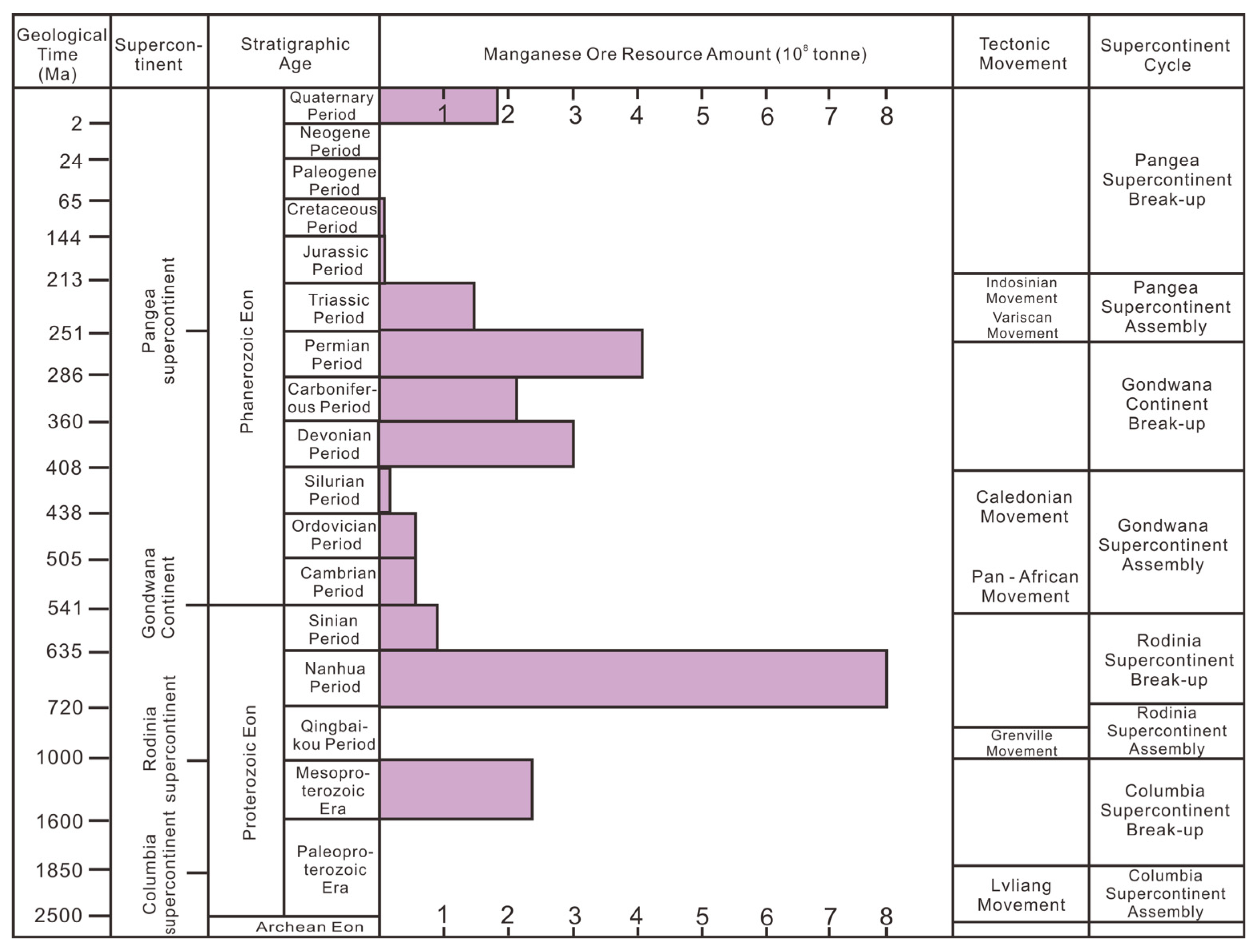Manganese Resources in China: An Overview of Resource Status and Recent Advances in Metallogenic Models and Exploration
Abstract
1. Introduction
2. Geochemical Properties of Manganese
3. Metallogenic Belts of Manganese Deposits in China
4. Types and Spatiotemporal Distribution of Manganese Deposits in China
4.1. General Characteriscs of Manganese Resources in China
- Deposit Size
- 2.
- Ore Grade and Quality
- 3.
- Impurities and Mining Conditions
4.2. Genetic Classification of Manganese Deposits
4.2.1. Sedimentary Manganese Deposits
4.2.2. Volcanogenic-Sedimentary Manganese Deposits
4.2.3. Hydrothermal Overprinted Stratabound Polymetallic Deposits
4.2.4. Magmatic-Hydrothermal Manganese Deposits
4.2.5. Metamorphosed Manganese Deposits
4.2.6. Supergene Manganese Deposits
4.3. Spatiotemporal Distribution of Manganese Deposits
4.3.1. Mesoproterozoic Mineralization Period
4.3.2. Neoproterozoic–Early Paleozoic Metallogenic Period
4.3.3. Late Paleozoic–Triassic Metallogenic Period
4.3.4. Quaternary Metallogenic Period
5. Recent Advances in Metallogenic Theories
6. Recent Trends in Prospecting Mn Ore Deposits
6.1. Breakthroughs in Deep and Peripheral Exploration of Metallogenic Belts
6.2. Breakthroughs in Frontier Stratigraphy
7. Conclusions and Future Perspectives
Author Contributions
Funding
Data Availability Statement
Conflicts of Interest
References
- Sun, X.; Hao, H.; Liu, Z.; Zhao, F. Insights into the global flow pattern of manganese. Resour. Policy 2020, 65, 101578. [Google Scholar] [CrossRef]
- Clarke, C.; Upson, S. A global portrait of the manganese industry—A socioeconomic perspective. NeuroToxicology 2017, 58, 173–179. [Google Scholar] [CrossRef] [PubMed]
- Li, S.; Yan, J.; Pei, Q.; Sha, J.; Mou, S.; Xiao, Y. Risk Identification and Evaluation of the Long-term Supply of Manganese Mines in China Based on the VW-BGR Method. Sustainability 2019, 11, 2683. [Google Scholar] [CrossRef]
- Zhao, X.; Han, X.; Feng, H.; Liu, L.; Liu, Q.; Liu, G.; Du, B.; Zhu, H. Study on China’s manganese resource demand from 2024 to 2035 based on GM-SVR method. Front. Earth Sci. 2025, 13, 1538908. [Google Scholar] [CrossRef]
- Kerroumi, M.; Karbak, M.; Afaryate, H.; El-Bchiri, A.; Aqil, M.; Manoun, B.; Tamraoui, Y.; Girault, H.; Ghamouss, F. Unveiling electrochemical insights of lithium manganese oxide cathodes from manganese ore for enhanced lithium-ion battery performance. Electrochim. Acta 2025, 509, 145286. [Google Scholar] [CrossRef]
- Maisel, F.; Neef, C.; Marscheider-Weidemann, F.; Nissen, N.F. A forecast on future raw material demand and recycling potential of lithium-ion batteries in electric vehicles. Resour. Conserv. Recycl. 2023, 192, 106920. [Google Scholar] [CrossRef]
- Miao, Y.; Liu, L.; Zhang, Y.; Tan, Q.; Li, J. An overview of global power lithium-ion batteries and associated critical metal recycling. J. Hazard. Mater. 2022, 425, 127900. [Google Scholar] [CrossRef]
- Ahmed, S.; Nelson, A.; Gallagher, G.; Susarla, N.; Dees, W. Cost and energy demand of producing nickel manganese cobalt cathode material for lithium ion batteries. J. Power Sources 2017, 342, 733–740. [Google Scholar] [CrossRef]
- Schmuch, R.; Wagner, R.; Hörpel, G.; Placke, T.; Winter, M. Performance and cost of materials for lithium-based rechargeable automotive batteries. Nat. Energy 2018, 3, 267–278. [Google Scholar] [CrossRef]
- Islam, S.; Ahmed, S.; Rousseau, A. Future Battery Material Demand Analysis Based on U.S. Department of Energy R&D Targets. World Electr. Veh. J. 2021, 12, 90. [Google Scholar] [CrossRef]
- Gao, K.; Sun, C.; Wang, Z. Recent advances in high-performance lithium-rich manganese-based materials for solid-state lithium batteries. Mater. Chem. Front. 2024, 8, 3082–3105. [Google Scholar] [CrossRef]
- Marincaş, A.-H.; Ilea, P. Enhancing Lithium Manganese Oxide Electrochemical Behavior by Doping and Surface Modifications. Coatings 2021, 11, 456. [Google Scholar] [CrossRef]
- Wang, H.; Geng, X.; Hu, L.; Wang, J.; Xu, Y.; Zhu, Y.; Liu, Z.; Lu, J.; Lin, Y.; He, X. Efficient direct repairing of lithium- and manganese-rich cathodes by concentrated solar radiation. Nat. Commun. 2024, 15, 1634. [Google Scholar] [CrossRef]
- Xu, C.; Dai, Q.; Gaines, L.; Hu, M.; Tukker, A.; Steubing, B. Future material demand for automotive lithium-based batteries. Commun. Mater. 2020, 1, 99. [Google Scholar] [CrossRef]
- Sokolova, I.; Nwaila, T.; Ntunka, G.; Klochkov, S.; Michaux, S.; Moscardini, E.; Toro, L.; Ghorbani, Y. From abundant resource to critical commodity: Forecasting manganese supply and assessing its sustainability. Sustain. Mater. Technol. 2025, 44, e01349. [Google Scholar] [CrossRef]
- Masias, A.; Marcicki, J.; Paxton, W.A. Opportunities and Challenges of Lithium Ion Batteries in Automotive Applications. ACS Energy Lett. 2021, 6, 621–630. [Google Scholar] [CrossRef]
- Helbig, C.; Bradshaw, A.M.; Wietschel, L.; Thorenz, A.; Tuma, A. Supply risks associated with lithium-ion battery materials. J. Clean. Prod. 2018, 172, 274–286. [Google Scholar] [CrossRef]
- U.S. Geological Survey. Mineral Commodity Summaries 2025; U.S. Geological Survey: Reston, VA, USA, 2025; p. 212. [CrossRef]
- Guo, X.; Lu, Y.; Zhang, Q.; Ren, J.; Cai, W. The Geological Characteristics, Resource Potential, and Development Status of Manganese Deposits in Africa. Minerals 2024, 14, 1088. [Google Scholar] [CrossRef]
- Tsikos, H.; Beukes, J.; Moore, M.; Harris, C. Deposition, Diagenesis, and Secondary Enrichment of Metals in the Paleoproterozoic Hotazel Iron Formation, Kalahari Manganese Field, South Africa. Econ. Geol. 2003, 98, 1449–1462. [Google Scholar] [CrossRef]
- Tsikos, H.; Moore, M. Petrography and geochemistry of the Paleoproterozoic Hotazel Iron-Formation, Kalahari manganese field, South Africa; implications for Precambrian manganese metallogenesis. Econ. Geol. 1997, 92, 87–97. [Google Scholar] [CrossRef]
- Chisonga, C.; Gutzmer, J.; Beukes, J.; Huizenga, M. Nature and origin of the protolith succession to the Paleoproterozoic Serra do Navio manganese deposit, Amapa Province, Brazil. Ore Geol. Rev. 2012, 47, 59–76. [Google Scholar] [CrossRef]
- Sun, H.; Wang, J.; Ren, J.; Zhang, W.; Tang, W.; Wu, X.; Gu, A. Current situation of global manganese resources and suggestions for sustainable development in China. Nat. Resour. Conserv. Res. 2021, 4, 53–61. [Google Scholar] [CrossRef]
- Maynard, B. The Chemistry of Manganese Ores through Time: A Signal of Increasing Diversity of Earth-Surface Environments. Econ. Geol. 2010, 105, 535–552. [Google Scholar] [CrossRef]
- Lv, Z.C.; Long, B.L.; Pang, Z.S.; Wang, Z.Q.; Yu, X.F.; Li, Y.S.; Yan, T.J.; Sun, H.R.; Zhen, S.M. Exploration progress and future exploration planning of main metal minerals in China since the strategic action for mineral exploration breakthroughs. Miner. Explor. 2024, 15, 1974–1990, (In Chinese with English Abstract). [Google Scholar]
- Ministry of Natural Resources, PRC. China Mineral Resources 2024; Geological Publishing House: Beijing, China, 2024; p. 53.
- Deng, W.B.; Zhang, Y.W.; Kong, L.H.; Shang, L. Current situation of manganese ore resources in China and screening of national-level manganese deposit physical geological data. China Min. Mag. 2019, 28, 175–182, (In Chinese with English abstract). [Google Scholar]
- Huang, Y.; Chen, G.Y.; Tian, Y.M.; Li, L.T.; Lei, Y.L.; Li, L.Z.; Zhang, Z.W.; Yang, P.; Huang, L.M. Main problems and countermeasures of manganese industry in China. Geol. Explor. 2021, 57, 294–304, (In Chinese with English Abstract). [Google Scholar]
- Zhao, G.; Feng, Y.; Du, H.; Han, L. Challenges and coping strategies of China’s dependence on foreign manganese ore resources. In Proceedings of the 2023 Chinese Geoscience Union Annual Meeting, Beijing, China, 18–19 December 2023. [Google Scholar]
- U.S. Geological Survey. Mineral Commodity Summaries 2021; U.S. Geological Survey: Reston, VA, USA, 2021; p. 200. [CrossRef]
- U.S. Geological Survey. Mineral Commodity Summaries 2023; U.S. Geological Survey: Reston, VA, USA, 2023; p. 210. [CrossRef]
- Mao, J.; Wu, H.; Wang, Z.; Liu, M.; Ren, H. Security of Manganese Resources and Industrial Chain in China. Chin. J. Eng. Sci. 2022, 24, 20–28. [Google Scholar] [CrossRef]
- Hu, S.; He, S.; Jiang, X.; Wu, M.; Wang, P.; Li, L. Forecast and suggestions on the demand of lithium, cobalt, nickel and manganese resources in China’s new energy automobile industry. IOP Conf. Ser. Earth Environ. Sci. 2021, 769, 042018. [Google Scholar]
- Cheng, L.; Fuchs, H.; Karplus, J.; Michalek, J. Electric vehicle battery chemistry affects supply chain disruption vulnerabilities. Nat. Commun. 2024, 15, 2143. [Google Scholar] [CrossRef]
- Sun, X. Supply chain risks of critical metals: Sources, propagation, and responses. Front. Energy Res. 2022, 10, 957884. [Google Scholar] [CrossRef]
- Zhou, Q.; Du, S.; Yuan, J.; Zhang, S.; Yang, N.; Pan, W.; Yu, C.; Wang, P.; Xu, Y.; Qi, J. Prospecting model of paleo-natural gas seepage sedimentary manganese deposits: A case study of the Nanhuaian “Datangpo-Type” manganese deposits in Guizhou-Hunan-Chongqing adjacent area. Acta Geol. Sin 2017, 91, 2285–2298, (In Chinese with English Abstract). [Google Scholar]
- Zhou, Q.; Du, S.; Yuan, J.; Zhang, S.; Xie, F.; Yang, N. Research history, main progress and prospect of Nanhuaian “Datangpo-Type” manganese deposits in eastern Guizhou and adjacent areas. Guizhou Geol. 2018, 35, 270–281, (In Chinese with English Abstract). [Google Scholar]
- Cheng, M.; Zhang, Z.; Hu, J.; Wang, H.; Cao, M.; Li, C. Reconciling redox proxy contradiction with active Fe Mn shuttle in the Cryogenian Nanhua Basin of South China. Palaeogeogr. Palaeoclimatol. Palaeoecol. 2025, 667, 112899. [Google Scholar] [CrossRef]
- Cui, H.; Kitajima, K.; Spicuzza, J.; Fournelle, H.; Denny, A.; Ishida, A.; Zhang, F.; Valley, W. Questioning the biogenicity of Neoproterozoic superheavy pyrite by SIMS. Am. Mineral. 2018, 103, 1362–1400. [Google Scholar] [CrossRef]
- Wang, P.; Algeo, J.; Zhou, Q.; Yu, W.; Du, Y.; Qin, Y.; Xu, Y.; Yuan, L.; Pan, W. Large accumulations of 34S-enriched pyrite in a low-sulfate marine basin: The Sturtian Nanhua Basin, South China. Precambrian Res. 2019, 335, 105504. [Google Scholar] [CrossRef]
- Yu, W.; Algeo, J.; Du, Y.; Maynard, B.; Guo, H.; Zhou, Q.; Peng, T.; Wang, P.; Yuan, L. Genesis of Cryogenian Datangpo manganese deposit: Hydrothermal influence and episodic post-glacial ventilation of Nanhua Basin, South China. Palaeogeogr. Palaeoclimatol. Palaeoecol. 2016, 459, 321–337. [Google Scholar] [CrossRef]
- Wu, C.; Zhang, Z.; Xiao, J.; Fu, Y.; Shao, S.; Zheng, C.; Yao, J.; Xiao, C. Nanhuan manganese deposits within restricted basins of the southeastern Yangtze Platform, China: Constraints from geological and geochemical evidence. Ore Geol. Rev. 2016, 75, 76–99. [Google Scholar] [CrossRef]
- Jiao, P.; Xiao, R.; Tan, S.; Xie, Y.; Fang, H.; Wen, Z.; Wang, Z. Evaluating Depositional Environment and Organic Matter Accumulation of Datangpo Formation in Central Hunan Province, South China. Minerals 2025, 15, 366. [Google Scholar] [CrossRef]
- Wang, Y.; Chen, D.; Liu, Z.C.; Xiao, L.; Dai, D.F.; Xiao, L. Main geological characteristics of the Shenxi hidden rich manganese deposit in Zunyi, Guizhou. Miner. Geol. 2020, 34, 689–695, (In Chinese with English Abstract). [Google Scholar]
- Zhou, Q.; Du, Y.S.; Yuan, L.J.; Zhang, S.; An, Z.Z.; Pan, W.; Yang, B.N.; Xie, X.F.; Yu, W.C.; Yin, S.L. Main progress in geological prospecting and potential prediction of the Songtao manganese deposit national integrated exploration area, Tongren, Guizhou. Guizhou Geol. 2016, 33, 237–244, (In Chinese with English Abstract). [Google Scholar]
- Chen, X.; Jiang, S. Discovery of the largest Carboniferous manganese deposit in Longtou-Limiao, central Guangxi, China. China Geol. 2018, 1, 312–313. [Google Scholar] [CrossRef]
- Yu, W.; Polgári, M.; Fintor, K.; Gyollai, I.; Szabó, M.; Velledits, F.; Liu, Z.; Du, Y. Contribution of microbial processes to the enrichment of Middle Permian manganese deposits in northern Guizhou, South China. Ore Geol. Rev. 2021, 136, 104259. [Google Scholar] [CrossRef]
- Yu, W.; Polgári, M.; Gyollai, I.; Fintor, K.; Szabó, M.; Kovács, I.; Fekete, J.; Du, Y.; Zhou, Q. Microbial metallogenesis of Cryogenian manganese ore deposits in South China. Precambrian Res. 2019, 322, 122–135. [Google Scholar] [CrossRef]
- Lovley, R. Fe(III) and Mn(IV) Reduction. In Environmental Microbe-Metal Interactions; American Society for Microbiology: Washington, DC, USA, 2000; pp. 1–30. [Google Scholar]
- Post, J.E. Manganese oxide minerals: Crystal structures and economic and environmental significance. Proc. Natl. Acad. Sci. USA 1999, 96, 3447–3454. [Google Scholar] [CrossRef]
- Polgari, M.; Okita, P.M.; Hein, J.R. Stable isotope evidence for the origin of the Urkut manganese ore deposit, Hungary. J. Sediment. Res. 1991, 61, 384–393. [Google Scholar] [CrossRef]
- Okita, P.M.; Shanks, W.C. Origin of stratiform sediment-hosted manganese carbonate ore deposits: Examples from Molango, Mexico, and TaoJiang, China. Chem. Geol. 1992, 99, 139–163. [Google Scholar] [CrossRef]
- Roy, S. Sedimentary manganese metallogenesis in response to the evolution of the Earth system. Earth-Sci. Rev. 2006, 77, 273–305. [Google Scholar] [CrossRef]
- Van, C.P.; Viollier, E. Cycling of iron and manganese in surface sediments: A general. Am. J. Sci. 1996, 32, 2931–2939. [Google Scholar]
- Böttcher, M.E.; Huckriede, H. First occurrence and stable isotope composition of authigenic γ-MnS in the central Gotland Deep (Baltic Sea). Mar. Geol. 1997, 137, 201–205. [Google Scholar] [CrossRef]
- Burke, I.; Kemp, A. Microfabric analysis of Mn-carbonate laminae deposition and Mn-sulfide formation in the Gotland Deep, Baltic Sea. Geochim. Cosmochim. Acta 2002, 66, 1589–1600. [Google Scholar] [CrossRef]
- Polgári, M.; Gyollai, I. Comparative Study of Formation Conditions of Fe-Mn Ore Microbialites Based on Mineral Assemblages: A Critical Self-Overview. Minerals 2022, 12, 1273. [Google Scholar] [CrossRef]
- Force, R.; Cannon, F. Depositional Model for Shallow-Marine Manganese Deposits around Black Shale Basins. Econ. Geol. 1988, 83, 93–117. [Google Scholar] [CrossRef]
- Frakes, L.; Bolton, R. Effects of Ocean Chemistry, Sea Level, and Climate on the Formation of Primary Sedimentary Manganese Ore Deposits. Econ. Geol. 1992, 87, 1207–1217. [Google Scholar] [CrossRef]
- Glasby, P.; Ren, X.; Shi, X.; Pulyaeva, A. Co–rich Mn crusts from the Magellan Seamount cluster: The long journey through time. Geo-Mar. Lett. 2007, 27, 315–323. [Google Scholar] [CrossRef]
- Huckriede, H.; Meischner, D. Origin and environment of manganese-rich sediments within black-shale basins. Geochim. Cosmochim. Acta 1996, 60, 1399–1413. [Google Scholar] [CrossRef]
- Crerar, A.; Barnes, L. Deposition of deep-sea manganese nodules. Geochim. Cosmochim. Acta 1974, 38, 279–300. [Google Scholar] [CrossRef]
- Hein, R.; Mizell, K.; Koschinsky, A.; Conrad, A. Deep-ocean mineral deposits as a source of critical metals for high- and green-technology applications: Comparison with land-based resources. Ore Geol. Rev. 2013, 51, 1–14. [Google Scholar] [CrossRef]
- Tebo, M.; Bargar, R.; Clement, G.; Dick, J.; Murray, J.; Parker, D.; Verity, R.; Webb, M. BIOGENIC MANGANESE OXIDES: Properties and Mechanisms of Formation. Annu. Rev. Earth Planet. Sci. 2004, 32, 287–328. [Google Scholar] [CrossRef]
- Yu, W.; Polgári, M.; Gyollai, I.; Fintor, K.; Huang, H.; Szabó, M.; Du, Y. Microbial metallogenesis of early carboniferous manganese deposit in central Guangxi, South China. Ore Geol. Rev. 2021, 136, 104251. [Google Scholar] [CrossRef]
- Gutzmer, J.; Beukes, J. Mineral paragenesis of the Kalahari managanese field, South Africa. Ore Geol. Rev. 1996, 11, 405–428. [Google Scholar] [CrossRef]
- Johnson, E.; Webb, M.; Ma, C.; Fischer, W. Manganese mineralogy and diagenesis in the sedimentary rock record. Geochim. Cosmochim. Acta 2016, 173, 210–231. [Google Scholar] [CrossRef]
- Böttcher, E. Manganese(II) partitioning during experimental precipitation of rhodochrosite–calcite solid solutions from aqueous solutions. Mar. Geol. 1998, 62, 287–297. [Google Scholar] [CrossRef]
- Fu, Y.; Xu, G.; Pei, X.; Jiang, R. Preliminary study on metallogenic regularity of manganese deposits in China. Acta Geol. Sin. 2014, 88, 2192–2207, (In Chinese with English Abstract). [Google Scholar]
- Cheng, X.; Hu, P.; Zhang, K.; Jiang, S. Main types, distribution characteristics and development status of manganese deposits. Geol. China 2021, 48, 102–119, (In Chinese with English Abstract). [Google Scholar]
- Cong, Y.; Dong, J.; Xiao, Y.; Chen, P.; Gao, B.; Yin, N. Characteristics and potential prediction of manganese ore resources in China. Earth Sci. Front. 2018, 25, 118–137, (In Chinese with English Abstract). [Google Scholar]
- Wu, H.; Wang, G.; Lu, M. Brief analysis of current situation of manganese ore resources in Guizhou and development suggestions. China Manganese Ind. 2022, 40, 6–10, (In Chinese with English Abstract). [Google Scholar]
- Niu, S.; Zhao, L.; Lin, X.; Chen, T.; Wang, Y.; Mo, L.; Niu, X.; Wu, H.; Zhang, M.; Huizenga, J.M.; et al. Mineralogical Characterization of Manganese Oxide Minerals of the Devonian Xialei Manganese Deposit. Minerals 2021, 11, 1243. [Google Scholar] [CrossRef]
- Yin, N.; Xiao, Y. Potential analysis and metallogenic prediction of manganese ore resources in China. Geol. China 2014, 41, 1424–1437, (In Chinese with English Abstract). [Google Scholar]
- Yan, Z.; Liu, W.; Yang, Y.; Cao, C.; An, J.; Huang, Y. Current situation of manganese resources and progress in development and utilization technology. China Manganese Ind. 2024, 42, 16–21, (In Chinese with English Abstract). [Google Scholar]
- Fan, D.; Yang, P. Introduction to and Classification of Manganese Deposits of China. Ore Geol. Rev. 1999, 15, 1–13. [Google Scholar] [CrossRef]
- Du, S.; Yu, C.; Zhou, Q.; Guo, H.; Jin, S.; Liu, C.; Huang, H.; Liu, H.; Wang, P.; Qi, J. Discussion on the coupling relationship between supercontinent breakup and large-scale manganese mineralization in China. J. Palaeogeogr. 2023, 25, 1211–1234, (In Chinese with English Abstract). [Google Scholar]
- Fan, D.; Ju, Y.; Li, J. Geology, mineralogy, and geochemistry of the Middle Proterozoic Wafangzi ferromanganese deposit, Liaoning Province, China. Ore Geol. Rev. 1999, 15, 31–53. [Google Scholar] [CrossRef]
- Duan, J.; Fu, Y.; Zhang, Z.; Xiao, J.; Wu, C. Genesis of the Dounan manganese deposit of southeast Yunnan, China: Constraints from the mineralogy and geochemistry of micronodules. J. Geochem. Explor. 2020, 214, 106541. [Google Scholar] [CrossRef]
- Teng, L. Types and genesis of manganese oxide ores in Guangxi, Southwest China. Chin. J. Geochem 1999, 18, 87–96. [Google Scholar] [CrossRef]
- Chen, F.; Wang, Q.; Yang, S.; Zhang, Q.; Liu, X.; Chen, J.; Carranza, E.J.M. Space-time distribution of manganese ore deposits along the southern margin of the South China Block, in the context of Palaeo-Tethyan evolution. Int. Geol. Rev. 2018, 60, 72–86. [Google Scholar] [CrossRef]
- Tan, C.; Lyu, Q.; Wang, T.; Li, Q.; Jiang, H.; Yan, X. Differential sedimentary evolution of typical aulacogens of Meso-Neoproterozoic in North China craton. Sci. Rep. 2024, 14, 4410. [Google Scholar] [CrossRef]
- Qian, X. Late Precambrian aulacogens of the North China craton. In Proceedings of the Conference on Terrestrial Planets: Comparative Planetology, Pasadena, CA, USA, 5–7 June 1985; LPI Contribution 575. pp. 115–117. [Google Scholar]
- Zhang, H.; Zhao, Y.; Ye, H.; Hu, M.; Wu, F. New constraints on ages of the Chuanlinggou and Tuanshanzi Formations of the Changcheng System in the Yan-Liao area in the northern North China Craton. Acta Petrol. Sin. 2013, 29, 2481–2490. [Google Scholar]
- Zeng, Y.; Liu, T. Characteristics of the Devonian Xialei manganese deposit, Guangxi Zhuang Autonomous Region, China. Ore Geol. Rev. 1999, 15, 153–163. [Google Scholar] [CrossRef]
- Chen, F.; Pufahl, K.; Wang, Q.; Matheson, J.; Shabaga, M.; Zhang, Q.; Zeng, Y.; Le, X.; Ruan, D.; Zhao, Y. A New Model for the Genesis of Carboniferous Mn Ores, Longtou Deposit, South China Block. Econ. Geol. 2022, 117, 107–125. [Google Scholar] [CrossRef]
- Tan, Z.; Xu, J.; Liao, F.; Luo, Y.; Li, S.; Wei, H.; Liao, J.; Fan, H. New precipitation mechanism in the Permian manganese ore belt in the central south China block: A case study of the Dongxiangqiao manganese deposit. Ore Geol. Rev. 2025, 183, 106693. [Google Scholar] [CrossRef]
- Zhao, J.; He, L.; Gong, J.; He, Z.; Feng, Z.; Pang, J.; Zeng, W.; Yan, Y.; Yuan, Y. Predicting Manganese Mineralization Using Multi-Source Remote Sensing and Machine Learning: A Case Study from the Malkansu Manganese Belt, Western Kunlun. Minerals 2025, 15, 113. [Google Scholar] [CrossRef]
- Zhang, B.; Zhang, L.; Feng, J.; Xu, S.; Feng, C.; Hao, Y.; Zheng, M.; Peng, Z.; Dong, Z. Genesis of the large-scale Orto Karnash manganese carbonate deposit in the Malkansu District, western Kunlun: Evidence from Geological Features. Geol. Rev. 2018, 64, 361–377. [Google Scholar]
- Zhang, L.; Zhang, B.; Dong, Z.; Xie, Y.; Li, W.; Peng, Z.; Zhu, M.; Wang, C. Tectonic setting and metallogenetic conditions of Carboniferous Malkansu giant manganese belt in West Kunlun Orogen. J. Jilin Univ. (Earth Sci. Ed.) 2020, 50, 1340–1357. [Google Scholar]
- Zhang, L.; Dong, Z.; Zhang, B.; Li, W.; Peng, Z.; Wang, C.; Zhu, M. Controlling factors and “Malkansu style” metallogenetic model of high grade manganese ore in West Kunlun orogen. Acta Geol. Sin 2022, 96, 3195–3210. [Google Scholar]
- Chen, D.; Sui, Q.; Guo, Z.; Zhao, X.; Teng, J.; Gao, Y. Sedimentary environment of Mn-bearing carbonate from the Muhu manganese deposit in Malkansu, West Kunlun: Evidences from Fusulinids and CO-Sr isotopes. Northwest. Geol. 2022, 55, 1–13. [Google Scholar]
- He, B.; Xu, Y.-G.; Guan, J.-P.; Zhong, Y.-T. Paleokarst on the top of the Maokou Formation: Further evidence for domal crustal uplift prior to the Emeishan flood volcanism. Lithos 2010, 119, 1–9. [Google Scholar] [CrossRef]
- Xianpei, C.; Duofu, C. Geochemistry of Upper Devonian hydrothermal mammilated chert Guangxi, Southwest China. Chin. J. Geochem. 1990, 9, 46–53. [Google Scholar] [CrossRef]
- Fan, D.; Liu, T.; Ye, J. The process of formation of manganese carbonate deposits hosted in black shale series. Econ. Geol. 1992, 87, 1419–1429. [Google Scholar] [CrossRef]
- Xiang, J.; Chen, J.; Bagas, L.; Li, S.; Wei, H.; Chen, B. Southern China’s manganese resource assessment: An overview of resource status, mineral system, and prediction model. Ore Geol. Rev. 2020, 116, 103261. [Google Scholar] [CrossRef]
- Garnit, H.; Kraemer, D.; Bouhlel, S.; Davoli, M.; Barca, D. Manganese ores in Tunisia: Genetic constraints from trace element geochemistry and mineralogy. Ore Geol. Rev. 2020, 120, 103451. [Google Scholar] [CrossRef]
- Maynard, B.; Kuleshov, V. (Eds.) Chapter 1—Manganese Rocks and Ores. In Isotope Geochemistry; Elsevier: Amsterdam, The Netherlands, 2017; pp. 1–4. [Google Scholar] [CrossRef]
- Scholz, F. Identifying oxygen minimum zone-type biogeochemical cycling in Earth history using inorganic geochemical proxies. Earth-Sci. Rev. 2018, 184, 29–45. [Google Scholar] [CrossRef]
- Sim, N.; Orians, K.J. Annual variability of dissolved manganese in Northeast Pacific along Line-P: 2010–2013. Mar. Chem. 2019, 216, 103702. [Google Scholar] [CrossRef]
- Hermans, M.; Lenstra, W.K.; van Helmond, N.A.G.M.; Behrends, T.; Egger, M.; Séguret, M.J.M.; Gustafsson, E.; Gustafsson, B.G.; Slomp, C.P. Impact of natural re-oxygenation on the sediment dynamics of manganese, iron and phosphorus in a euxinic Baltic Sea basin. Geochim. Cosmochim. Acta 2019, 246, 174–196. [Google Scholar] [CrossRef]
- Zhou, Q.; Wu, C.; Hu, X.; Yang, B.; Zhang, X.; Du, Y.; Xu, K.; Yuan, L.; Ni, J.; Hu, D.; et al. A new metallogenic model for the giant manganese deposits in northeastern Guizhou, China. Ore Geol. Rev. 2022, 149, 105070. [Google Scholar] [CrossRef]
- Dong, J.; Zhang, S.; Jiang, G.; Zhao, Q.; Li, H.; Shi, X.; Liu, J. Early diagenetic growth of carbonate concretions in the upper Doushantuo Formation in South China and their significance for the assessment of hydrocarbon source rock. Sci. China Earth Sci. 2008, 51, 1330–1339. [Google Scholar] [CrossRef]
- Jiang, G.; Shi, X.; Zhang, S.; Wang, Y.; Xiao, S. Stratigraphy and paleogeography of the Ediacaran Doushantuo Formation (ca. 635-551 Ma) in South China. Gondwana Res. 2011, 19, 831–849. [Google Scholar] [CrossRef]
- Yu, W.C.; Du, Y.S.; Zhou, Q.; Wang, P.; Qi, J.; Xu, Y.; Jin, S.; Pan, W.; Yuan, L.J.; Xie, X.F. Coupling relationship between sedimentary mineralization of “Datangpo-Type” manganese deposits and major geological events during Chengbing Period in South China. J. Palaeogeogr. 2020, 22, 855–871, (In Chinese with English Abstract). [Google Scholar]
- Gumsley, A.; Chamberlain, K.; Bleeker, W.; Söderlund, U.; de Kock, M.; Larsson, E.; Bekker, A. Timing and tempo of the Great Oxidation Event. Proc. Natl. Acad. Sci. USA 2017, 114, 1811–1816. [Google Scholar] [CrossRef] [PubMed]
- Yu, W.; Algeo, T.J.; Du, Y.; Zhou, Q.; Wang, P.; Xu, Y.; Yuan, L.; Pan, W. Newly discovered Sturtian cap carbonate in the Nanhua Basin, South China. Precambrian Res. 2017, 293, 112–130. [Google Scholar] [CrossRef]
- Xu, H.; Gao, J.; Yang, R.; Du, L.; Liu, Z.; Chen, J.; Feng, K.; Yang, G. Genesis for Rare Earth Elements Enrichment in the Permian Manganese Deposits in Zunyi, Guizhou Province, SW China. Acta Geol. Sin. 2020, 94, 90–102. [Google Scholar] [CrossRef]
- Xu, H.; Gao, J.; Yang, R.; Feng, K.; Wang, L.; Chen, J. Metallogenic mechanism of large manganese deposits from Permian manganese ore belt in western South China Block: New mineralogical and geochemical evidence. Ore Geol. Rev. 2021, 132, 103993. [Google Scholar] [CrossRef]
- Hu, L. Geological characteristics of shenxi manganese deposit in Honghuagang District, Zunyi, Guizhou. China Manganese Ind. 2021, 39, 27–30. [Google Scholar]
- Liu, Z.; Zhou, Q.; Liu, K.; Wang, Y.; Chen, D.; Chen, Y.; Xiao, L. Sedimentary Features and Paleogeographic Evolution of the Middle Permian Trough Basin in Zunyi, Guizhou, South China. J. Earth Sci. 2023, 34, 1803–1815. [Google Scholar] [CrossRef]
- Liu, Z.; Zhou, Q.; Yang, R.; Du, Y.; Chen, D.; Xiao, L. Main Metallogenic Regularity and Metallogenic Zone Division of Permian Manganese Deposits in Northern Guizhou-Eastern Yunnan Province. Multipurp. Util. Miner. Resour. 2024, 45, 62–72. [Google Scholar] [CrossRef]
- Zhang, L.; Wang, L.; Robbins, J.; Zhang, C.; Konhauser, O.; Dong, G.; Li, J.; Peng, D.; Zheng, T. Petrography and Geochemistry of the Carboniferous Ortokarnash Manganese Deposit in the Western Kunlun Mountains, Xinjiang Province, China: Implications for the Depositional Environment and the Origin of Mineralization. Econ. Geol. 2020, 115, 1559–1588. [Google Scholar] [CrossRef]
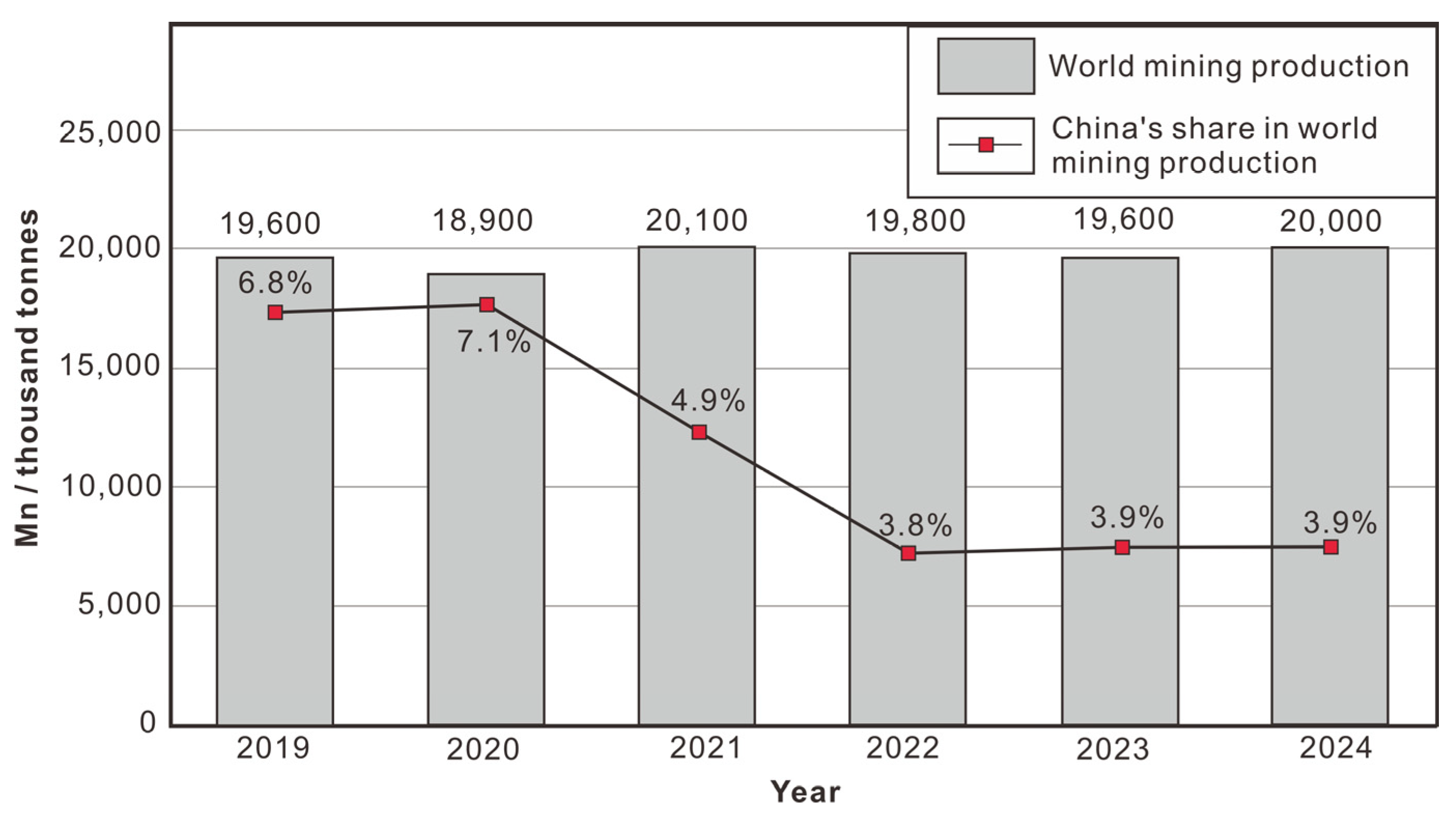
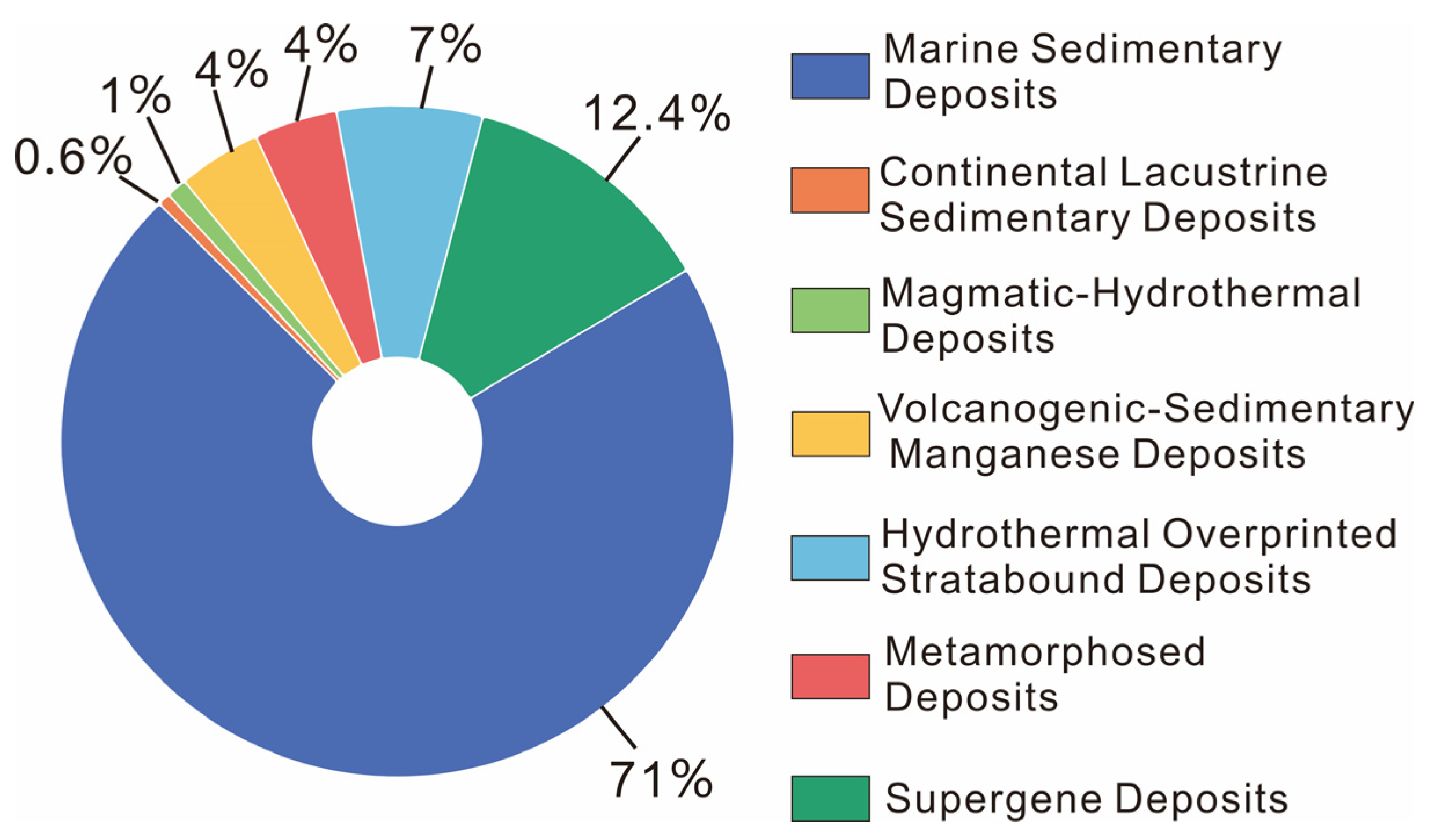

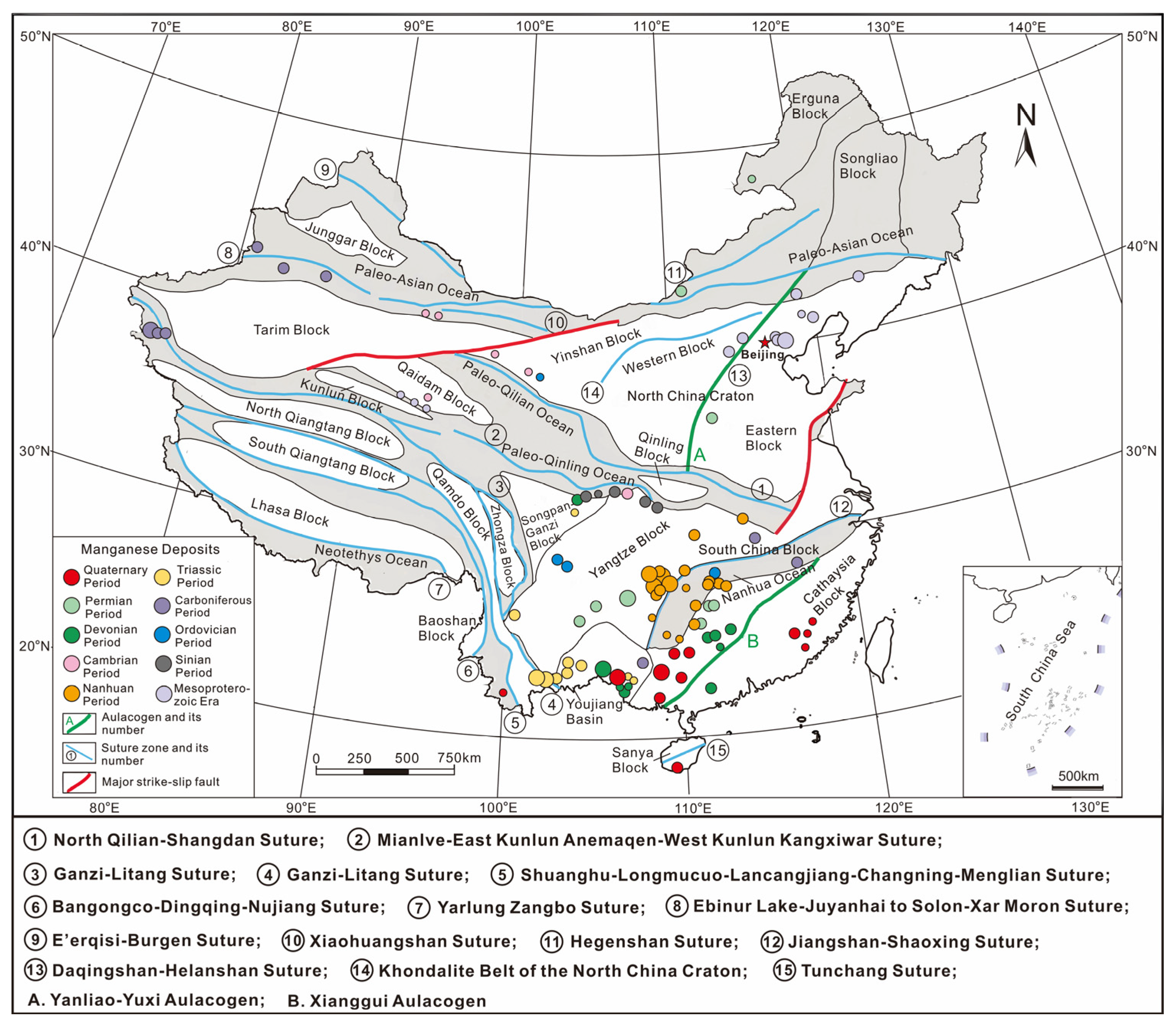
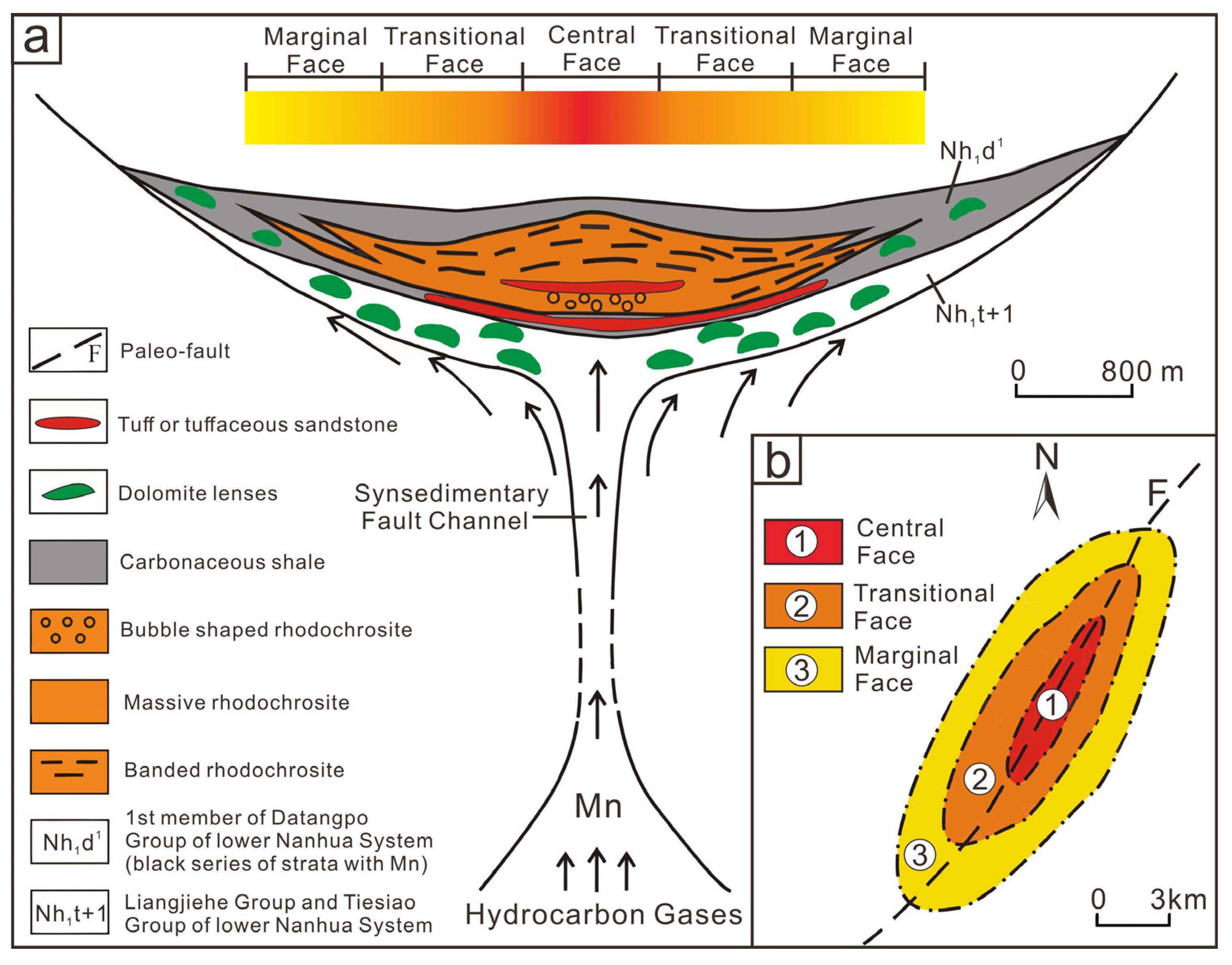
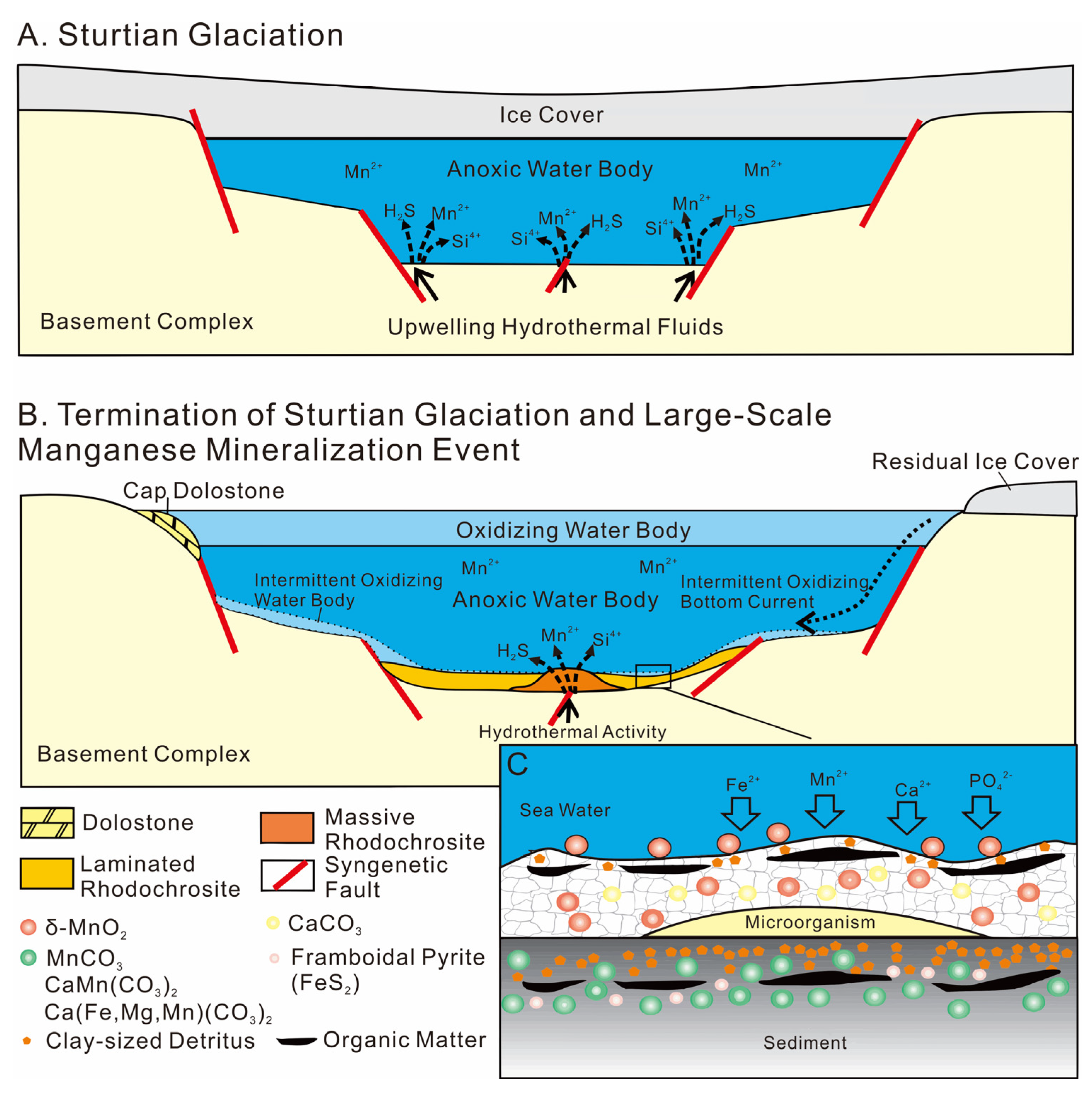
| Metallogenic Province | Metallogenic Belt | Metallogenic Age | Representative Deposits |
|---|---|---|---|
| North China Craton Domain | Yanliao-Taihang Metallogenic Belt | Mesoproterozoic | Dongshuichang (Tianjin), Wafangzi (Liaoning) |
| Yangtze Platform Domain | Peri-Yangtze Platform Marginal Metallogenic Belt | Meso-Neoproterozoic | Gucheng, Dongbawan (Hubei) |
| Southeastern Yangtze Platform Margin Metallogenic Belt | Early Sinian and Middle Ordovician | Datangpo (Guizhou), Minle, Ziganshan (Hunan) | |
| Northern Yangtze Platform Margin Metallogenic Belt | Late Sinian–Early Cambrian | Lijiaying, Tiantaishan (Shaanxi) | |
| Western Yangtze Platform Margin Metallogenic Belt | Middle-Late Ordovician and Middle-Late Triassic | Qiaodingshan, Huya (Sichuan) | |
| Intra-Yangtze Platform Metallogenic Belt | Late Carboniferous–Early Permian | Tongluojing (Guizhou), Gexue (Yunnan) | |
| South China Orogen Domain | Nanpanjiang-Youjiang Basin Metallogenic Belt | Late Devonian–Early Carboniferous and Early-Middle Triassic | Mugui, Xialei, Longtou, Dongping (Guangxi); Dounan, Baixian (Yunnan) |
| Hunan-Guangxi-Guangdong Basin Metallogenic Belt | Middle-Late Devonian and Early-Late Permian | Houjiangqiao, Dongxiangqiao (Hunan); Xiaodai (Guangdong); Bayi, Pingle (Guangxi) | |
| Southwestern Fujian-Eastern Guangdong Metallogenic Belt | Late Paleozoic–Early Triassic | Lanqiao, Miaoqian (Fujian) | |
| Sanjiang Orogen Domain | Southwestern Yunnan Tethyan Metallogenic Belt | Proterozoic, Permian, and Triassic | Xiaolongtan, Baye, Laoguang (Yunnan) |
| Qilian-Tianshan Orogen Domain | Qilian Orogen Metallogenic Belt | Early Paleozoic | Heixiakou, Bianmagou, Zhongbao (Gansu) |
| Tianshan Accretionary Metallogenic Belt | Late Paleozoic | Motuosala, Kalanggou, Zhaosu (Xinjiang) | |
| Kunlun Orogen Metallogenic Belt | Mesoproterozoic and Carboniferous | Aoertuokanashi (Xinjiang); Langmuri (Qinghai) |
| Deposit Type | Resource Proportion (%) | Sub-type | Formation Environment | Host Rock | Main Metallogenic Age |
|---|---|---|---|---|---|
| Marine sedimentary | 71 | Carbonate Mn deposits in black shales | Continental rift-related nearshore, semi-enclosed bays or restricted basins | Interbedded carbonaceous shales, siliceous rocks, etc. | Nanhuan, Permian |
| Mn-oxide-carbonate deposits in fine clastic rocks | Shallow marine environments along continental margins | Clastic-carbonates | Devonian | ||
| Oxide-carbonate Mn deposits in carbonate rocks | Shallow marine platform margins | Dolomite, silty dolomite, dolomitic limestone | Mesoproterozoic, Carboniferous | ||
| Carbonate Mn deposits in siliceous-argillaceous limestone | Marginal shelf settings | Siliceous limestone, argillaceous limestone | Triassic | ||
| Continental lacustrine sedimentary | 0.6 | – | Shallow lacustrine or swamp environments | Mudstone and claystone | Permian |
| Volcanic-sedimentary | 4 | – | Orogenic rift troughs and marginal zones, associated with volcanic activity | Interbedded siliceous rocks, carbonates, etc. | Carboniferous, Sinian |
| Hydrothermal Overprinted Stratabound | 7 | – | Post-depositional hydrothermal alteration in sedimentary-tectonic settings | Carbonate rocks | Devonian |
| Metamorphosed | 4 | Regional metamorphic deposits | Regional metamorphism of primary marine sedimentary formations | Phyllites, argillaceous siltstones | Triassic, Cambrian |
| Contact metamorphic deposits | Contact aureoles of magmatic intrusions | Metamorphosed slates or greenschists | Indosinian, Yanshanian | ||
| Supergene | 12.4 | Residual cap deposits | Weathered zones of primary deposits | Carbonate rocks | Quaternary |
| Leached deposits | Structural fracture zones, interlayer fissures, karst cavities | Clastic rocks, carbonate rocks | Quaternary | ||
| Accumulation deposits | Residual-slope deposits, clay-subclay layers | Eluvium, deluvium | Quaternary | ||
| Magmatic-Hydrothermal | 1 | – | Post-magmatic or volcanic hydrothermal environment | Limestone, argillaceous limestone, schist | Yanshanian |
| Host Deposit | Mineralization Age | Metallogenic Belt | Ore-Bearing Horizon | Deposit Type | Ore Type | Newly Added Resource/Estimated Reserve 1 (104 tonnes) |
|---|---|---|---|---|---|---|
| Gaodi (Guizhou) | Nanhua | Southeastern Yangtze Platform Margin Metallogenic Belt | Datangpo Formation | Marine sedimentary | Mainly Mn carbonate | 66,000 2/ 16,500 |
| Daotuo (Guizhou) | ||||||
| Taoziping (Guizhou) | ||||||
| Xixibao (Guizhou) | ||||||
| Muhu, Aoertuokanashi, Markan (Xinjiang) | Ordovician–Silurian | Tianshan Accretionary Metallogenic Belt | Kalaatehe Formation | Marine sedimentary | Mainly Mn carbonate | 10,000/ 2170 |
| Xialei (Guangxi) | Devonian | Nanpanjiang-Youjiang Basin Metallogenic Belt | Wuzhishan Formation | Marine sedimentary | Mn carbonate and Mn oxide | 3500/ 700 |
| Lilei-Tangling (Guangxi) | Carboniferous | Nanpanjiang-Youjiang Basin Metallogenic Belt | Datangpo Formation | Marine sedimentary | Mainly Mn carbonate | 8000/ 1080 |
| Shenxi (Guizhou) | Permian | Intra-Yangtze Platform Metallogenic Belt | Maokou Formation | Marine sedimentary | Mainly Mn carbonate | 2000/ 398 |
| Dongxiangqiao, Daotianchong (Hunan) | Permian | Hunan-Guangxi-Guangdong Basin Metallogenic Belt | Gufeng Formation | Marine sedimentary | Mainly Mn carbonate | 7600/ 1520 |
| Santonggoubei, Hongshuihe (Qinghai) | Triassic | Qilianshan Orogen Metallogenic Belt | Kuhai Formation | Marine sedimentary | Mainly Mn carbonate | 3000/ 510 |
| Dongping (Guangxi) | Triassic | Nanpanjiang-Youjiang Basin Metallogenic Belt | Beisi Formation | Marine sedimentary and Supergene | Marine sedimentary and Supergene | 21,000/ 2520 |
| Fuwan (Guangxi) | Triassic | Nanpanjiang-Youjiang Basin Metallogenic Belt | Beisi Formation | Marine sedimentary and Supergene | Marine sedimentary and Supergene | 10,000/ 750 |
Disclaimer/Publisher’s Note: The statements, opinions and data contained in all publications are solely those of the individual author(s) and contributor(s) and not of MDPI and/or the editor(s). MDPI and/or the editor(s) disclaim responsibility for any injury to people or property resulting from any ideas, methods, instructions or products referred to in the content. |
© 2025 by the authors. Licensee MDPI, Basel, Switzerland. This article is an open access article distributed under the terms and conditions of the Creative Commons Attribution (CC BY) license (https://creativecommons.org/licenses/by/4.0/).
Share and Cite
Peng, E.; Yang, J.; Wang, Z.; Li, D.; Gao, Y.; Yan, D.; Chen, Y.; Guo, X. Manganese Resources in China: An Overview of Resource Status and Recent Advances in Metallogenic Models and Exploration. Minerals 2025, 15, 859. https://doi.org/10.3390/min15080859
Peng E, Yang J, Wang Z, Li D, Gao Y, Yan D, Chen Y, Guo X. Manganese Resources in China: An Overview of Resource Status and Recent Advances in Metallogenic Models and Exploration. Minerals. 2025; 15(8):859. https://doi.org/10.3390/min15080859
Chicago/Turabian StylePeng, Erke, Jianguang Yang, Zhilin Wang, Dong Li, Yuanxing Gao, Danyang Yan, Yanfei Chen, and Xueyi Guo. 2025. "Manganese Resources in China: An Overview of Resource Status and Recent Advances in Metallogenic Models and Exploration" Minerals 15, no. 8: 859. https://doi.org/10.3390/min15080859
APA StylePeng, E., Yang, J., Wang, Z., Li, D., Gao, Y., Yan, D., Chen, Y., & Guo, X. (2025). Manganese Resources in China: An Overview of Resource Status and Recent Advances in Metallogenic Models and Exploration. Minerals, 15(8), 859. https://doi.org/10.3390/min15080859








